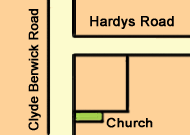Wesleyan Methodist School (1864)
| It is thought that the Wesleyan Methodist congregation used their church building for both a school and worship services. Its location was on a block adjoining Dee's southern boundary on the eastern side of the Clyde-Berwick Road, Clyde North. A board of Trustees were responsible for this school. It was not recognised as an ordinary day school by the contemporary Schools’ Inspector and nor was it only a one day a week Sunday School. The Wesleyan Methodist Sunday School had been operating since 1859 |
In 1864, within a 2 mile radius of School No 118 were 69 children, 41 Church of England, 12 Roman Catholic, 5 Presbyterians and 11 Wesleyans. (Clyde North School Committee Report July 21, 1864)
It is the unlawful behaviour of a Mr Churchill, resulting in a police report which acknowledges the existence of the school in 1867.Police Report 5 August 1867
CRANBOURNE.-On Saturday (before Messrs. Adams, chairman, J. Wedge, and Patterson, J. P.'s), Mr. Cadd and the trustees of the Wesleyan school at the Clyde sued Mr. Churchill for illegally detaining stools, forms, &c., the property of the trustees. It appeared from the evidence that Churchill had sold the ground on which the school was built to the trustees, for the sum of one shilling, but had afterwards opened the door with a false key, and taken the things complained of. Mrs. Churchill said she had been served with a summons, but though her husband was in the house after the service she had never told him, and had taken the things back. The Bench said the case might have been made one of felony, but as the summons had been worded "detaining," and as the things had been taken back, they would dismiss the case, with 5s. costs against the defendant.
The Argus, 7 August 1867 |
The legislation of 1872 made education both free and compulsory. All schools were renamed state schools and came under the control of the Education Department. Local Committees were replaced by Boards of Advice which had a measure of control over schools in a district. Cranbourne Board of Advice controlled State School 118 (Clyde North), State School 144 (Cranbourne Presbyterian).
Return to Top>>
Sources
1. History of Clyde North School
2. The Argus
3. A Clyde History

